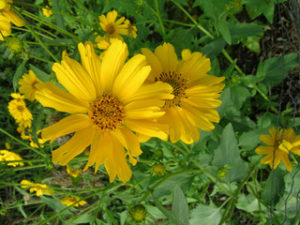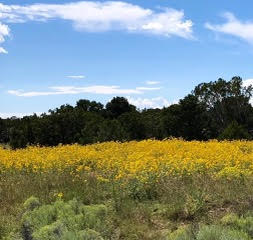Scientific name: Verbesina encelioides
Common names: cowpen daisy, golden crownbeard, butter daisy
Family: Asteraceae (Compositae)
Article by Jeanne Gozigian

Close up of Verbesina encelioides (cowpen daisy) leaves and flowers. Photo by Janice Tucker.
How could such a lovely daisy-like flower, known for its grand stands of golden/yellow blossoms and being a primary host to butterflies and moths, be given the rather vulgar common name of cowpen daisy? Acres of roadside beauty should not be thus dismissed.
Verbesina encelioides (Ver-bes-SIGH-nuh en-see-lee-OY-deez) is an annual herb that likes to grow in disturbed soil, like cow pens, but can be very happy in other disturbed areas. They make impressive displays as they bloom from April through October in the US. They are happiest in full light in sand and loam soils but will tolerate dappled light. The stems are tallest, up to 5 feet, with more light. Verbesina refers to leaves resembling some verbenas and encelia refers to Compositae, in that encilia is a genus in the Aster/Compositae family. Cowpen daisy has shown invasive characteristics because of seed production and dispersal in Pacific islands, however where it is native it has not been classified invasive.

ield of of Verbesina encelioides – cowpen daisy off Highway 599, Santa Fe, NM. Photo by Janice Tucker.
The 2 inch flower heads, with 10-15, 3-toothed rays like blanket flowers, surround a yellow disc. Their native range spans from California to Arizona, New Mexico to Texas, Utah, Colorado, Montana, east to Kansas. They continue south into Mexico. The alternate, gray-green, lance-shaped foliage has toothed margins. Lower leaves are triangular and opposite; all leaves have fine hairs. They grow in full sun from seed propagation and only need low water to thrive. Collect seeds that have dried on plants or purchase online from Plants of the Southwest. It is deer resistant. In the wild, the seeds are eaten by doves and goldfinches because they are favorites. This ensures their dispersal.
The wonder of the cowpen daisy is its major role as a late season larval food plants to the pollinator bordered patch butterfly, Chlosyne lacinia. It is a valuable nectar source for other black, white and orange butterflies in the Nymphalidae family– notably monarchs, Danaus plexippus. Although monarchs exclusively lay their eggs in milkweed species (Asclepias spp.), they use V. encelioides as an important nectar food source in their incredible migrations. Cowpen daisies are a great late summer food supply. The golden moth, Basilodes pepita, also uses V. encelioides as a larval host plant. The nectar is also of great value for honeybees. Silvery checkerspot (Chlosyne nyceteis) caterpillars can strip the plants of all greenery but that does not kill them; monarchs can always find them to feast on their nectar.
Thus, the lowly cowpen daisy stands tall with pride of importance as a much-needed plant to support many other organisms in the biodiverse habitat.
Thanks to Janice Tucker and Helen Woody for proofreading this article.
Sources:
Dave’s Garden, Verbena species, American Dogweed, Butter Daisy, Cowpen Daisy
https://davesgarden.com/guides/pf/go59964#b
Golden Crownbeard, Wildflowers of New Mexico
www.wildflowersnm.com/Wildflowers_of_New_Mexico/Verbesina encelioides.html
Leslie Miller, Cowpen Daisies, a Fall Butterfly and Bee Favorite, Planters Place
www.plantersplace.com/wildlife…/cowpen-daisies-a-fall-butterfly-and-bee-favorite/
Native American Seed, https://www.seedsource.com
Pollinator Favorite: Cowpen Daisy Plays Host to Bordered Patch Butterfly
https://texasbutterflyranch.com/2017/03/31/cowpendaisy
Stearn, William T., Stearn’s Dictionary of Plant Names for Gardeners, Cassell Publishers Limited, London, 1992
Verbesina encelioides, (cowpen daisy), Native Plant of North America
https://www.wildflower.org/plants/result.php?id_plant=VEEN
Monarch Butterfly, Wikipedia
https://en.wikipedia.org/wiki/Monarch_butterfly#Larval_host-plants


